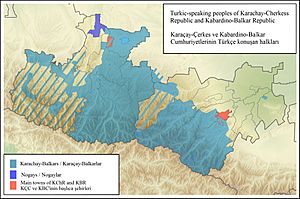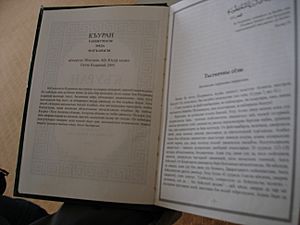Karachay-Balkar facts for kids
Quick facts for kids Karachay-Balkar |
||||
|---|---|---|---|---|
| къарачай-малкъар тил таулу тил |
||||
| Native to | North Caucasus | |||
| Region | Kabardino-Balkaria, Karachay–Cherkessia, Turkey | |||
| Ethnicity | Karachays, Balkars | |||
| Native speakers | 310,000 in Russia (2010 census) | |||
| Language family |
Turkic
|
|||
| Dialects |
Karachay
Balkar
|
|||
| Writing system | Cyrillic Latin in diaspora |
|||
| Official status | ||||
| Official language in | Kabardino-Balkaria (Russia) Karachay-Cherkessia (Russia) |
|||
 |
||||
|
||||
Karachay-Balkar (Къарачай-Малкъар тил, Qaraçay-Malqar til) is a Turkic language. It is also sometimes called Mountain Turkic (Таулу тил, Tawlu til). This language is spoken by two groups of people, the Karachays and the Balkars.
Most speakers live in Kabardino-Balkaria and Karachay–Cherkessia in European Russia. You can also find people who speak Karachay-Balkar in Afyonkarahisar Province, Turkey. The language has two main ways of speaking, called dialects. These are the Karachay-Baksan-Chegem dialect and the Malkar dialect. The main difference is how certain sounds are pronounced. The written form of the language today is based on the Karachay-Baksan-Chegem dialect. Karachay-Balkar is very similar to the Kumyk language.
Contents
How Karachay-Balkar is Written
For a long time, the Karachay-Balkar language was written using the Arabic alphabet. This was until 1924. We still have old handwritten books and poems from that time, like those by the Balkar poet Kazim Mechiev. The first printed books in Karachay-Balkar came out in the early 1900s.
After the October Revolution in Russia, there was a big change. The Soviet government wanted to use the Latin alphabet for many languages. So, Karachay and Balkar teachers created a new alphabet using Latin letters. But in the 1930s, the government changed its mind. They decided that languages in the USSR should use the Cyrillic alphabet instead. Because of this, a new alphabet based on Cyrillic letters was officially adopted in 1937–1938.
The Karachay-Balkar Alphabet
Today, the Karachay-Balkar language mostly uses the Cyrillic alphabet. Below is a table showing the letters used in the modern Karachay-Balkar Cyrillic alphabet. Each letter also shows its sound.
| А а /a/ |
Б б /b/ |
В в /v/ |
Г г /g/ |
Гъ гъ |
Д д /d/ |
Дж дж /dʒ/ |
Е е /je/ |
| Ё ё /ø, jo/ |
Ж ж** /ʒ/ |
З з /z/ |
И и /i/ |
Й й /j/ |
К к /k/ |
Къ къ /q/ |
Л л /l/ |
| М м /m/ |
Н н /n/ |
Нг нг /ŋ/ |
О о /o/ |
П п /p/ |
Р р /r/ |
С с /s/ |
Т т /t/ |
| У у /u, w/ |
Ф ф* /f/ |
Х х /x/ |
Ц ц /ts/ |
Ч ч /tʃ/ |
Ш ш /ʃ/ |
Щ щ | |
| ъ |
Ы ы /ɯ/ |
ь |
Э э /e/ |
Ю ю /y, ju/ |
Я я /ja/ |
- The letter Ф ф is not found in words that originally come from Karachay-Balkar.
In Kabardino-Balkaria, people often write ж instead of дж. In Karachay-Cherkessia, they write нъ instead of нг. Sometimes, especially in older books, you might see the letter у́ or ў for a specific sound.
Here is the Karachay-Balkar Latin alphabet that was used for a short time:
| A a | B в | C c | Ç ç | D d | E e | F f | G g |
| Ƣ ƣ | I i | J j | K k | Q q | L l | M m | N n |
| Ꞑ ꞑ | O o | Ө ө | P p | R r | S s | Ş ş | T t |
| Ь ь | U u | V v | Y y | X x | Z z | Ƶ ƶ |
Comparing Alphabets Over Time
The Karachay-Balkar language has used different alphabets throughout its history. This table shows how letters from the Arabic, Latin, and different Cyrillic alphabets compare to each other. It helps us see how the writing system changed over the years.
An Example of the Language
Here is Article 1 from the Universal Declaration of Human Rights written in Karachay-Balkar. It shows how the language looks in both Cyrillic and Latin alphabets, along with its English translation. This article talks about how all people are born free and equal.
| In Cyrillic | In Cyrillic (1961-1964) | Transliteration | Yañalif | Translation |
|---|---|---|---|---|
| Бютеу адамла эркин болуб эмда сыйлары бла хакълары тенг болуб тууадыла. Алагъа акъыл бла намыс берилгенди эмда бир-бирлерине къарнашлыкъ халда къараргъа керекдиле. | Бүтеу адамла эркин болуб эмда сыйлары бла хақлары тең болуб тууадыла. Алаға ақыл бла намыс берилгенди эмда бир-бирлерине қарнашлық халда қарарға керекдиле. | Bütew adamla erkin bolub emda sıyları bla haqları teñ bolub tuwadıla. Alağa aqıl bla namıs berilgendi emda bir-birlerine qarnaşlıq halda qararğa kerekdile. | Byteu adamla erkin ʙoluʙ emda sьjlarь ʙla xalqlarь teꞑ ʙoluʙ tuuadьla. Alaƣa aqьl ʙla namьs ʙerilgendi emda ʙir-ʙirlerine qarnaşlьq xalda qararƣa kerekdile. | All human beings are born free and equal in dignity and rights. They are endowed with reason and conscience and should act towards one another in a spirit of brotherhood. |
Numbers in Karachay-Balkar
Learning numbers is a fun way to start understanding a new language. Here are some basic numbers in Karachay-Balkar. You can also see how they compare to two related languages, Kumyk and Nogay.
| Numeral | Karachay-Balkar | Kumyk | Nogay |
|---|---|---|---|
| 0 | ноль | ноль | ноль |
| 1 | бир | бир | бир |
| 2 | эки | эки | эки |
| 3 | юч | уьч | уьш |
| 4 | тёрт | дёрт | доьрт |
| 5 | беш | беш | бес |
| 6 | алты | алты | алты |
| 7 | джети | етти | йети |
| 8 | сегиз | сегиз | сегиз |
| 9 | тогъуз | тогъуз | тогыз |
| 10 | он | он | он |
| 100 | бир джюз | бир юз | бир юз |
Words from Other Languages
Like many languages, Karachay-Balkar has borrowed words from other languages. It has many words that come from Ossetian, Kabardian, Arabic, and Persian. This shows how different cultures and languages have connected over time.
See also
 In Spanish: Idioma karachái-bálkaro para niños
In Spanish: Idioma karachái-bálkaro para niños


